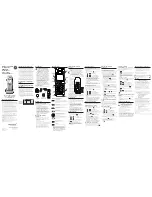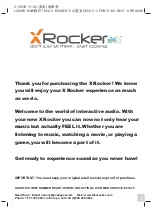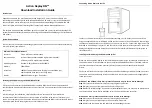
Operation, Safety and Installation Manual |
Li.ONESS Batteries
5
•
Discharging Temperature range: -20
o
C to +55
o
C
(-4
o
F to +131
o
F).
•
Recommended Operating range: 15
o
C to +30
o
C
(+59
o
F to +86
o
F).
•
Relative humidity: 15% - 90% @ 25 ±5
o
C
(+77
o
F ±9
o
F).
•
Atmospheric pressure: 86KPa~106KPa @ 25 ±5
o
C
(+77
o
F ±9
o
F).
1.6 Storage
i. Standard Storage Temperature (more than 1 month)
0°C to +35
o
C (+32
o
F to +95
o
F).
ii. Absolute Storage Temperature Short term
(less than 1 month): -20°C +55°C (-4
o
F to +131
o
F).
iii. Storage Humidity: <70%RH
iv. Store the battery in the state of 50% - 65% SoC.
Stored batteries should be fully charged (100%)
and discharged at ~60% every four months.
v. Store Li.ONESS batteries in separate storage area,
in case of mixed storage of other goods. Keep 2.5m
(98.42in) distance between the batteries and the
other goods.
vi. Limited quantities shall be stored in each area, for
example, for a 100 m
2
(1076.39ft
2
) area the quantity
should not be larger than 10 euro-pallets or an
equivalent of 10 m
3
(13.08yd
3
) of batteries.
vii. The safety team of the storage area shall define
the required safety measures.
1.7 Li.ONESS operational conditions
The Energy Storage System (ESS) operates at
temperature from -20 to +55
o
C (-4
o
F to +131
o
F) with
maximum humidity of 85%.
Rooms that do not meet the above temperature
characteristics must have controlled air-condition
support.
The Energy Storage System must not be directly
exposed to sunlight.
1.8 Certifications
•
Battery Module level: UN38.3
•
Cell level: IEC62619-2017, UN 38.3 and UL 1642
1.9 Product Life
The product life is specified at the warranty
documentation.
1.10 Disposal
Lithium-Ion batteries are subject to disposal and
recycling regulations that vary by country and region.
Always check and follow your applicable regulations
before disposing of any battery.
Dispose of the Li-ion battery in accordance with local,
state and federal laws and regulations.
Many countries prohibit the disposal of waste
electronic equipment in standard waste receptacles.
Batteries may be returned to the manufacturer if no
disposal and recycling regulations are in place.
Do not mix with other (industrial) waste.
1.11 Acronyms
•
ESS – Energy Storage System
•
Li.ONESS – Sunlight Lithium ESS
•
BMS – Battery Management System
•
MAB – Master Board
•
CMU – Cell Management Unit
•
PBT – Parallel Battery Topology PCB
•
SOC – State of Charge
•
SOH – State of Health
•
P.U. – Power Unit
•
PBT Unit – Parallel Battery Topology unit
1.12 Installation Tools
•
13mm Torch wrench (Connection Poles)
•
PH2 Insulated Cross head screwdriver (Sliding Rails
on U-rail)
•
SW10 Insulated socket wrench (modules on U-rail)
•
12mm German polygon (Sliding rails)
EN
Note
This document does not replace the inverter’s
manufacturer instructions. All settings that refer to the
inverter can only be found at manufacturer’s website.






































